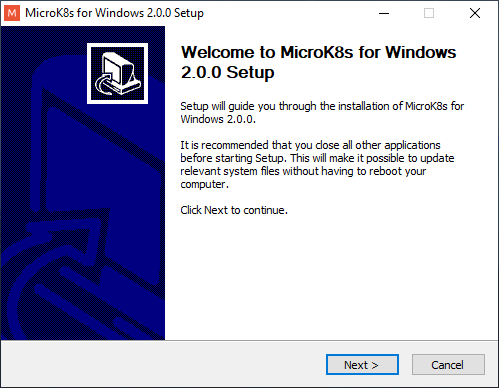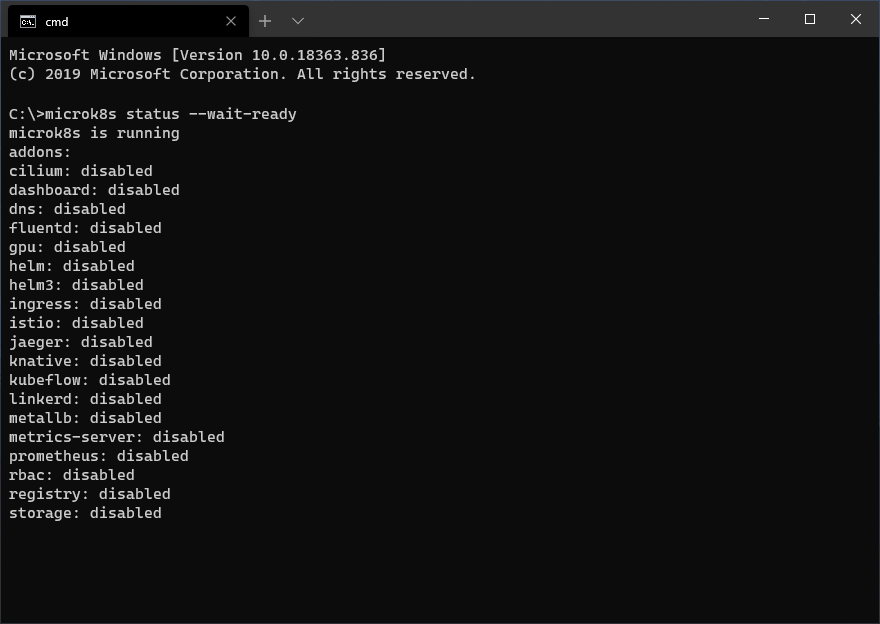The effortless Kubernetes
Zero-ops, pure-upstream, HA Kubernetes, from developer workstations to production.
What is MicroK8s
Why MicroK8s
The best Kubernetes experience for developers, DevOps, cloud and edge
For Developers
MicroK8s is the easiest and fastest way to get Kubernetes up and running. Experiment with the latest upstream features and toggle services on and off. Seamlessly move your work from dev to production.
For DevOps
With self-healing high availability, transactional OTA updates and secure sandboxed kubelet environments, MicroK8s is the go-to platform for mission-critical workloads. Quickly spin nodes up in your CI/CD and reduce your production maintenance costs.
For software vendors
Leverage the simplicity, robustness and security of MicroK8s as a full embedded Kubernetes platform. Build containerised solutions with a system that doesn't require your attention. Focus on your customers, not the infrastructure.
Hassle-free Kubernetes
The simplest way to get K8s anywhere
ARM or Intel. Under the cell tower. On Raspberry Pis. On clouds or everyday appliances. MicroK8s delivers the full Kubernetes experience with a single command.
Install. Cluster. Enable the services you need. No hassle.
A fully isolated deployment package protects your underlying system. Self-healing high-availability and over-the-air updates for ultra-reliable operations.
MicroK8s architecture and OS compatibility allows you to deploy on COTS hardware and develop on any workstation.
Install MicroK8s

-
Install MicroK8s on Linux
sudo snap install microk8s --classicDon't have the
snapcommand? Get set up for snaps -
Check the status while Kubernetes starts
microk8s status --wait-ready -
Turn on the services you want
microk8s enable dashboardmicrok8s enable dnsmicrok8s enable registrymicrok8s enable istioTry
microk8s enable --helpfor a list of available services and optional features.microk8s disable <name>turns off a service. -
Start using Kubernetes
microk8s kubectl get all --all-namespacesIf you mainly use MicroK8s you can make our kubectl the default one on your command-line with
alias mkctl="microk8s kubectl". Since it is a standard upstream kubectl, you can also drive other Kubernetes clusters with it by pointing to the respective kubeconfig file via the--kubeconfigargument. -
Access the Kubernetes dashboard
microk8s dashboard-proxy -
Start and stop Kubernetes to save battery
Kubernetes is a collection of system services that talk to each other all the time. If you don't need them running in the background then you will save battery by stopping them.
microk8s startandmicrok8s stopwill do the work for you.
Join the community

-
Download the installer for Windows
-
Run the Installer

-
Open a command line

-
Check the status while Kubernetes starts
microk8s status --wait-ready -
Turn on the services you want
microk8s enable dashboardmicrok8s enable dnsmicrok8s enable registrymicrok8s enable istioTry
microk8s enable --helpfor a list of available services built in. microk8s disable turns off a service. -
Start using Kubernetes
microk8s kubectl get all --all-namespacesIf you mainly use MicroK8s you can run the native Windows version of kubectl on your command-line.
-
Access the Kubernetes dashboard
microk8s dashboard-proxy -
Start and stop Kubernetes to save battery
Kubernetes is a collection of system services that talk to each other all the time. If you don't need them running in the background then you will save battery by stopping them.
microk8s startandmicrok8s stopwill do the work for you.
Join the community

-
Install MicroK8s on macOS
brew install ubuntu/microk8s/microk8smicrok8s install
Don't have the
brewcommand? Get it from the Homebrew website -
Check the status while Kubernetes starts
microk8s status --wait-ready -
Turn on the services you want
microk8s enable dashboardmicrok8s enable dnsmicrok8s enable registrymicrok8s enable istioTry
microk8s enable --helpfor a list of available services built in.microk8s disableturns off a service. -
Start using Kubernetes
microk8s kubectl get all --all-namespacesIf you mainly use MicroK8s you can run the native macOS version of kubectl on your command-line.
-
Access the Kubernetes dashboard
microk8s dashboard-proxy -
Start and stop Kubernetes to save battery
Kubernetes is a collection of system services that talk to each other all the time. If you don't need them running in the background then you will save battery by stopping them.
microk8s startandmicrok8s stopwill do the work for you.
Join the community
Enterprise support option, no licence fees
99.9% uptime SLA and 10-year security maintenance
As the publishers of MicroK8s, we deliver the world's most efficient multi-cloud, multi-arch Kubernetes through high quality packages and distribution channels.
A single subscription covers your physical and cloud native infrastructure and your applications on top.
Zero-ops infrastructure
Set it up and let it run
Our goal is to eliminate toil from Kubernetes cluster administration. MicroK8s needs just a few minutes to set up fully-functional highly-available clusters, with automated K8s datastore maintenance and unattended security updates. Fire and forget or customise it for your needs.
The most popular cloud native projects at your fingertips. No config needed
Prometheus is popular for metrics, so we bundled it. Just like Jaeger, Istio, LinkerD and KNative.
Turn them on or off with one command. Or bring your own addon if you like.
MicroK8s also comes with sensible defaults for the most widely used Kubernetes options, so it 'just works' with no config necessary.
Minimal, CNCF-certified distribution
All upstream services in an efficient package
Build your container strategy on a conformant platform, leverage the cloud native ecosystem, no vendor lock in. Get all Kubernetes services in a single, fully contained package. No moving parts and dependencies, better security and simpler ops.


Automatic security updates and streamlined upgrades
Let it roll, or take control
MicroK8s will apply security updates automatically by default, and roll back on failure. Defer them if you want.
Upgrade to a newer version of Kubernetes with a single command. It's really that easy. Stick with a major version, or follow the latest upstream work. Go with the flow, or take control in the enterprise to specify versions with perfect precision.
Experience MicroK8s
Watch the intro video. Pause and copy commands straight from this text console.
Datasheet
Looking for a more composable Kubernetes?
If MicroK8s is too opinionated for you, do not worry. MicroK8s is built by the Kubernetes team at Canonical. We also make Charmed Kubernetes for total control of all the permutations of Kubernetes components. Build your clusters from the ground up and tailor them to your needs.
Insure your MicroK8s clusters with enterprise support
Get in touch with our team of Kubernetes experts


